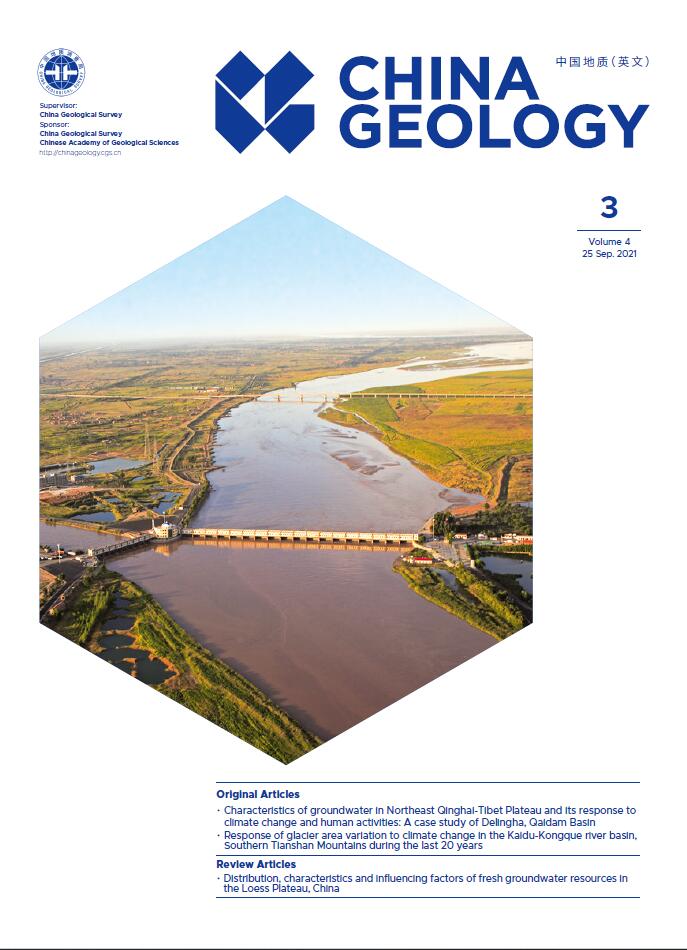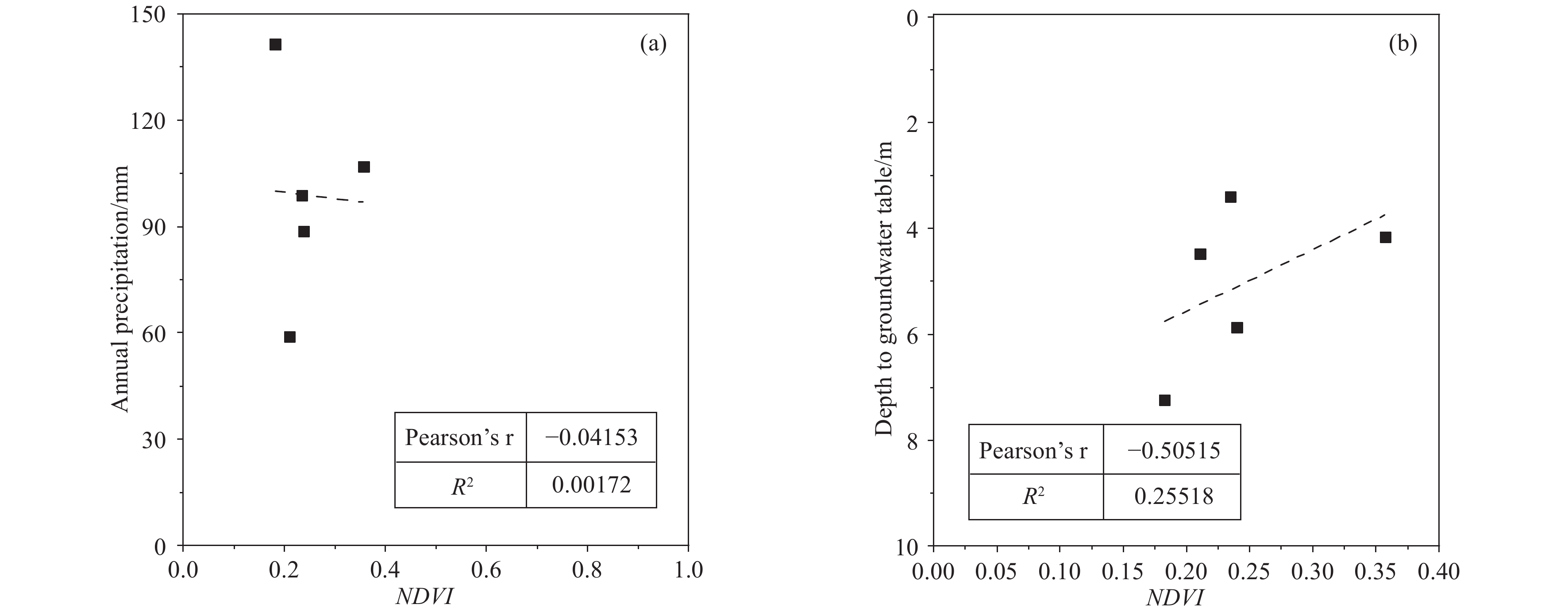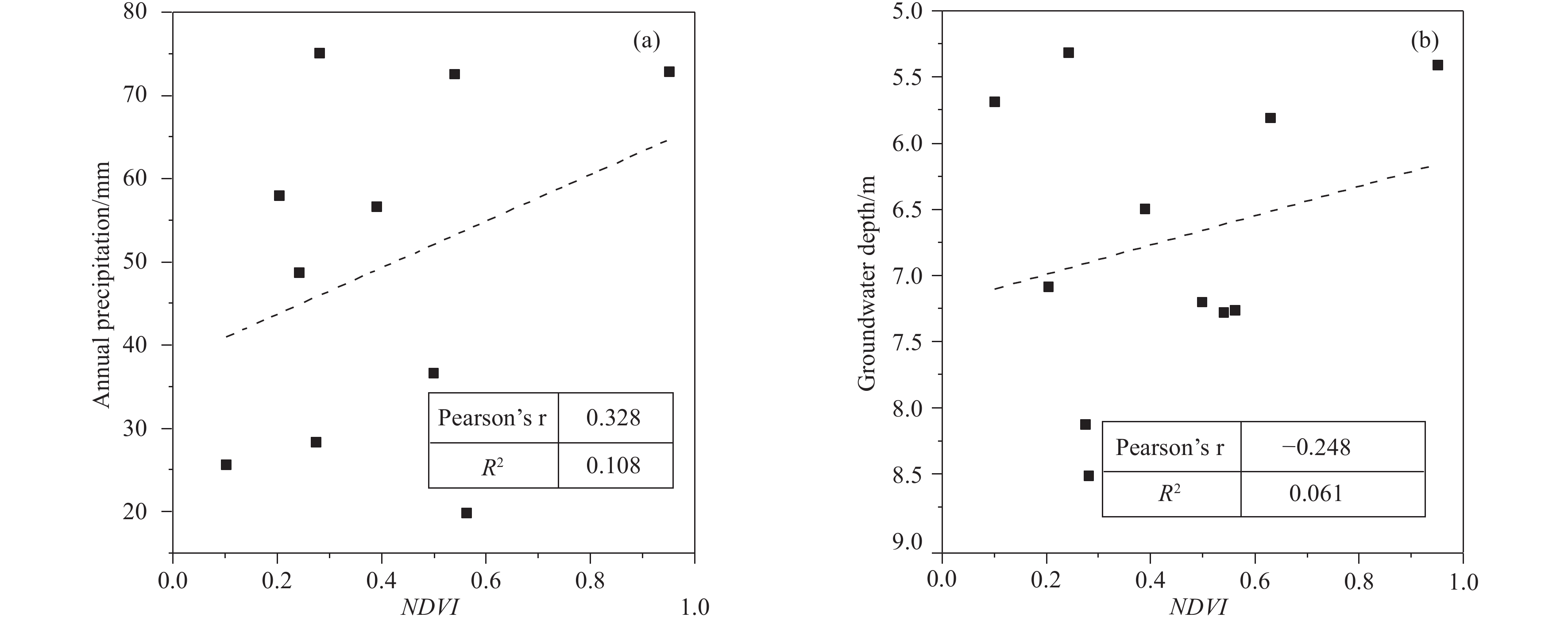| Citation: | Ge Song, Jin-ting Huang, Bo-han Ning, Jia-wei Wang, Lei Zeng, 2021. Effects of groundwater level on vegetation in the arid area of western China, China Geology, 4, 527-535. doi: 10.31035/cg2021062 |
Effects of groundwater level on vegetation in the arid area of western China
-
Abstract
At present, investigation about the relationship between the change of groundwater level and vegetation mostly focuses on specific watersheds, i.e. limited in river catchment scale. Understanding the change of groundwater level on vegetation in the basin or large scale, be urgently needed. To fill this gap, two typical arid areas in the west of China (Tarim Basin and Qaidam Basin) were chosen the a typical research area. The vegetation status was evaluated via normalization difference vegetation index (NDVI) from 2000 to 2016, sourced from MODN1F dataset. The data used to reflect climate change were download from CMDSC (http://data.cma.cn). Groundwater level data was collected from monitor wells. Then, the relationship of vegetation and climate change was established with univariate linear regression and correlation analysis approach. Results show that: Generally, NDVI value in the study area decreased before 2004 then increased in the research period. Severe degradation was observed in the center of the basin. The area with an NDVI value > 0.5 decreased from 12% to 6% between 2000 and 2004. From 2004 to 2014, the vegetation in the study area was gradually restored. The whole coverage of Qaidam Basin was low. And the NDVI around East Taigener salt-lake degraded significantly, from 0.596 to 0.005, 2014 and 2016, respectively. The fluctuation of groundwater level is the main reason for the change of surface vegetation coverage during the vegetation degradation in the basin. However, the average annual precipitation in the study area is low, which is not enough to have a significant impact on vegetation growth. The annual average precipitation showed an increase trend during the vegetation restoration in the basin, which alleviates the water shortage of vegetation growth in the region. Meanwhile, the dependence of surface vegetation on groundwater is obviously weakened with the correlation index is −0.248. The research results are of some significance to eco-environment protection in the arid area of western China.
-
Keywords:
- NDVI /
- Groundwater level /
- Climate change /
- Arid land /
- Hydrogeological survey engineering /
- Tarim Basin /
- Qaidam Basin /
- Western China
-

-
References
Bai YF, Chen CQ, Xu HL, Zhang GP, Zhang P, Ling HB. 2016. Relationship between spatial distribution of aboveground biomass of desert vegetation and groundwater depth in the lower reaches of Tarim River, Xinjiang, China. Scientia Silvae Sinicae, 52(11), 1–10. doi: 10.11707/j.1001-7488.20161101. Chen YN, Li WH, Xu HL, Liu JZ, Zhang HF, Chen YP. 2003. The influence of groundwater on vegetation in the lower reaches of Tarim River, China. Acta Geographica Sinica, 58(4), 542–549. doi: 10.3321/j.issn:0375-5444.2003.04.008. Chen YN. 2014. Research on Water Resources in Arid Area of Northwest China. Beijing, Science Press (in Chinese). Fan ZL, Chen YN, Li P, Ma YJ, Alicicil K, Abu D. 2008. Determination of suitable ecological groundwater depth in arid areas in northwest part of China. Journal of Arid Land Resources and Environment, 22(2), 1–5. doi: 10.3969/j.issn.1003-7578.2008.02.001. Guo ZR, Liu HT. 2005. Eco-depth of groundwater table for natural vegetation in inland basin, northwestern China. Journal of Arid Land Resources and Environment, 19(3), 157–161. doi: 10.1111/j.1744-7909.2005.00184. Hao XM, Chen YN, Li WH, Zhao RF, Zhu CG. 2008. Response of desert riparian forest vegetation to groundwater depth changes in the middle and lower Tarim River. Acta Geographica Sinica, 63(11), 1123–1130. doi: 10.3321/j.issn:0375-5444.2008.11.001. He L, Wang C, Bi Q, Zhao CY. 2013. Monitoring of desertification dynamics in Kenya during 2001‒2010 using MOD13Q1 data. Journal of Desert Research, 33(1), 46–52. doi: 10.7522/j.issn.1000-694X.2013.00007. Han L. 2014. The dynamics of vegetation and ecological characteristics of dominant populations for desert riparian forest in the upper reaches of Tarim River. Beijing, China Agricultural University, Ph.D thesis, 1–169 (in chinese with English abstract). Li XY, Zhang XM, Zeng FJ, Andrea F, Frank MT, Li XM, Michael R, He XY. 2002. Water relations on alhagi sparsifolia in the southern fringe of taklamakan deaert. Acta Botanica Sinica, 44(10), 1219–1224. Moffett KB, Gorelick SM, McLaren RG. 2012. Salt marsh ecohydrological zonation due to heterogeneous vegetation-groundwater-surface water interactions. Water Resources Research, 48(2), W02516. doi: 10.1029/2011WR010874. Ma M, Veroustraete F. 2005. Reconstructing pathfinder AVHRR land NDVI time-series data for the Northwest of China. Advances in Space Research, 37(4), 835–840. doi: 10.1016/j.asr.2005.08.037. Ma XD, Chen YN, Zhu CG, Li WH. 2011. The variation in soil moisture and the appropriate groundwater table for desert riparian forest along the lower tarim river. Journal of Geographical Sciences, 21(1), 150–162. doi: 10.1007/s11442-011-0835-8. Ma YL, Wang D, Liu JM, Wen XH, Gao M, Shao HB. 2013. Relationship between typical vegetation, soil salinity, and groundwater depth in the Yellow River Delta of China. Chinese Journal of Applied Ecology, 24(9), 2423–2430. Orellana F, Verma P, Loheide SP. 2012. Monitoring and modeling water-vegetation interactions in groundwater-dependent ecosystems. Reviews of Geophysics, 50, RG3003. doi: 10.1029/2011RG000383. Rains MC, Mount JF, Larsen EW. 2004. Simulated changes in shallow groundwater and vegetation distributions under different reservoir operations scenarios. Ecological Applications, 14(1), 192–207. doi: 10.1890/02-5307. Robinson DA, Campbell CS, Hopmans JW, Hornbuckle BK, Jones SB, Knight R, Ogden F, Selker J, Wendroth O. 2008. Soil moisture measurement for ecological and hydrological watershed-scale observatories: A review. Vadose Zone Journal, 7(1), 358–389. doi: 10.2136/vzj2007.0143. Rodriguez-Iturbe I. 2000. Ecohydrology: A hydrologic perspective of climate-soil-vegetation dynamies. Water Resources Research, 36(1), 3–9. doi: 10.1029/1999WR900210. Scanlonbe BR, Keese KE, Flint AL, Flint LE, Gaye CB, Edmunds WM, Simmers I. 2006. Global synthesis of ground water recharge in semiarid and arid regions. Hydrological Processes, 20(15), 3335–3370. doi: 10.1002/hyp.6335. Song CY, Liu GH, Liu QS, Cao MC, Huang C. 2008. Distribution pattern of plant communities in the Yellow River Delta and related affecting factors. Chinese Journal of Ecology, 27(12), 2042–2048. Wang XY, Xun HL, Pan CD. 2017. Change features of cultivated land resources and its driving factors in tarim river basin. Bulletin of Soil and Water Conservation, 37(2), 327–332. doi: 10.13961/j.cnki.stbctb.2017.02.050. Wang XY, Xu HL, Pan CD, Ling HB, Zhang P. 2016. Relation of dominant herbaceous plant species to groundwater depth in the lower reaches of tarim river. Journal of Desert Research, 36(1), 216–224. doi: 10.7522/j.issn.1000-694X.2014.00195. Wei ZF, Wang DG, Zhang C, Liu XF, Zhang H. 2014. Response of vegetation cover to climate change and human activities in Northwest China during 1999 to 2010. Journal of Desert Research, 34(6), 1665–1670. doi: 10.7522/j.issn.1000-694X.2014.00032. Xu HL, Ye M, Li JM. 2007. The dynamic changes of groundwater and the ecological response of natural vegetation after water conveyance in the lower reaches of the Tarim River. The Progress of Natural Science, 17(4), 460–470. doi: 10.3321/j.issn:1002-008X.2007.04.007. Yang PN. 2005. Study on Restoration of Groundwater and Vegetation in Lower Reaches of Tarim River after Intermittent Water Transportation. Urumqi, Xinjiang Agricultural University, Ph.D thesis, 1–135 (in chinese with English abstract). Zeng B, Yang TB. 2009. Natural vegetation responses to warming climates in Qaidam Basin 1982–2003. International Journal of Remote Sensing, 30(21), 5685–5701. doi: 10.1080/01431160902729556. Zhao CY, Li SB, Jia YH, Jiang YC. 2008. Dynamic in change of groundwater level and vegetation in water table fluctuant belt in lower reaches of Heihe River. Chinese Journal of Applied Ecology, 19(12), 2687–2692. Zhao WZ, Liu H. 2006. Recent advances in desert vegetation response to groundwater table changes. Acta Ecologica Sinica, 26(8), 2702–2708. doi: 10.3321/j.issn:1672-9072.2002.10.015. Zhao CY, Wang YC, Li BG. 2003. Coupling relationship between vegetation evolution and groundwater flow in internal continent river basin. Journal of Hydraulic Engineering, 12, 59–65. doi: 10.3321/j.issn:0559-9350.2003.12.009. -
Access History

-
Figure 1.
Groundwater monitoring wells distribution in Tarim and Qaidam basins, China.
-
Figure 2.
NDVI distribution in Tarim Basin from 2000 to 2014. a‒2000; b‒2004; c‒2008; d‒2014.
-
Figure 3.
Surface vegetation cover.
-
Figure 4.
NDVI distribution in Qaidam Basin from 2014 to 2016. a‒2014; b‒2015; c‒2016; d‒the proportion of green space and desert area.
-
Figure 5.
Spase correlation analysis of annual precipitation, groundwater and NDVI in Kongque River catchment. a‒the realationship of precipitation and NDVI; b‒the realationship of goundwater depth and NDVI.
-
Figure 6.
The relationship of groundwater depth and NDVI in the Tarim Basin, China. a‒relationship of groundwater depth and NDVI; b‒the relationship of groundwater depth and NDVI in the central of the basin; c‒the relationship of groundwater depth and NDVI in the east of the basin.
-
Figure 7.
Correlation analysis of NDVI with depth to groundwater table and precipitation in Tarim Basin from 2005 to 2014. a–the relationship of Precipitation and NDVI; b–the relationship of depth to groundwater table and NDVI.
-
Figure 8.
Relationship between depth to groundwater table and NDVI in central tarim basin from 2004 to 2008.





 DownLoad:
DownLoad:






